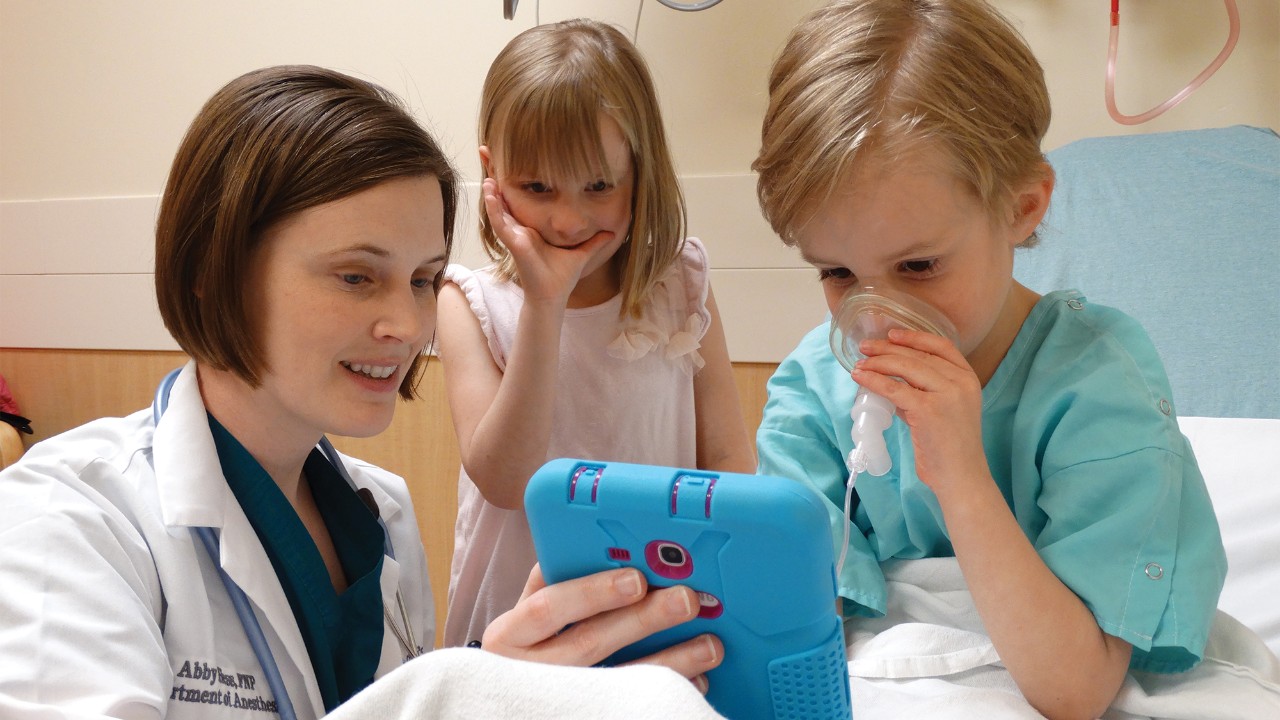
Alumna develops app to reduce pediatric patients' anxiety before surgery
Abby Winterberg Hess' zoo-themed adventure game is undergoing clinical research trials
By Katie Coburn
Studies show children who fall asleep calmly with anesthesia tend to experience better outcomes after surgery, including less delirium, pain and negative behavioral changes.
“For decades, research studies have demonstrated the clinical importance of optimizing anesthesia induction experiences, but we lacked a standardized clinical tool to document pediatric induction behaviors,” says Abby Winterberg Hess, DNP, a three-time graduate of the University of Cincinnati College of Nursing.
To change that, she developed, validated and implemented an electronic tool designed to document pediatric behavioral responses to anesthesia inductions, currently used in hospitals internationally. And, to take her findings a step further, she developed a zoo-themed gaming app, now undergoing clinical research trials. The app helps children use a breathing mask for anesthesia induction and distracts them before surgery, ultimately reducing their anxiety and improving outcomes.
Recognizing Needs
Winterberg Hess started working as a research assistant at Cincinnati Children’s in 2005. In 2009, she received a Bachelor of Science in Nursing from UC and accepted a registered nurse position at Children’s in the post-anesthesia care unit. She went on to earn her Master of Science in Nursing at UC, and in 2012, shortly after entering UC's Doctor of Nursing Practice (DNP) program, Winterberg Hess transitioned into a nurse practitioner role in a pediatric pre-anesthesia consult clinic at Children’s, where she frequently encountered patients with preoperative anxiety.
“We would formulate a preoperative plan for kids, but then we’d send them to the operating room and there was no documentation of how they did when they went to sleep,” she says. “So, we didn’t really know if what we were doing was positively impacting patients or not.”
The lack of documentation also prevented Winterberg Hess and her colleagues from knowing which strategies to use for returning patients who had prior anesthetics. In 2013, she dedicated her final DNP project—required to graduate from the program—to addressing the issue.
Assessing Behaviors to Improve Outcomes
In the following year, she studied scientific literature, developed staff education and collaborated with anesthesia experts and the electronic health records team at Children’s to develop a user-friendly electronic tool called CIBA (Child Induction Behavioral Assessment), which enabled documentation of induction behaviors in busy clinical settings.
In May 2014, a year before she earned her DNP, Winterberg Hess implemented CIBA at Children’s and, in 2015, she received a grant from the hospital’s anesthesia department to validate the tool. With the support of Children’s anesthesia chief, she created a new role within the department that allowed her to lead the validation study, results of which were published in Anesthesia & Analgesia in December 2018.
Since its validation, the Children’s anesthesia department has regularly used the tool to document the more than 30,000 patients seen on an annual basis. In May 2019, CIBA was integrated into Epic, the electronic health records system used by health care organizations throughout the world. As a result, CIBA is now used at The Hospital for Sick Children in Toronto, Children’s Hospital of Philadelphia and Great Ormond Street Hospital in London.
Leveraging Technology
Winterberg Hess’ commitment to improving patient outcomes didn’t stop there.
“I was also really interested in identifying which interventions were successful in helping decrease patients’ anxiety before surgery and how we could leverage technology to further improve those interventions,” she says.
In 2016, she suggested creating a breathing-controlled, gaming app to help pediatric patients feel comfortable using an anesthesia mask before entering the operating room. Though still undergoing clinical research trials, the app is a zoo adventure-themed video game patients play on a tablet to practice breathing through an anesthesia mask. Not only does it give patients an idea of what to expect in the operating room, it serves as a form of distraction when they're falling asleep before surgery, says Winterberg Hess.
For her idea, Winterberg Hess won Johnson & Johnson's first Nurses Innovate QuickFire Challenge, from which she and her team at Cincinnati Children's received funding and access to mentoring and coaching from Johnson & Johnson to help bring the concept to life. Winterberg Hess hopes to commercialize the app in the next few years.
According to Winterberg Hess, nurses are in a unique position to drive improvements in health care.
“I think the sky is the limit in terms of what we as nurses can accomplish in leadership, innovation, quality improvement and research,” she says. “Because we have direct patient care experience at the bedside, nurses have the ability to develop unique solutions that can transform health care, and it’s up to all of us to push that forward.”

Winterberg Hess' zoo-themed gaming app teaches children to breathe through an anesthesia mask by tasking them with blowing up balloons.
Featured image at top: UC alumna Abby Winterberg Hess demonstrates her app, designed to reduce children's anxiety prior to surgery. Guillermina Gomez/Submitted
Tags
Related Stories
World class: Alumni travel program connects Bearcats on global scale
January 7, 2026
Most people have a natural curiosity to see the world. Meanwhile, most Bearcats enjoy being around other Bearcats. Alumni can check both boxes through the UC Alumni Association’s travel program, which offers about half a dozen excursions each year to fascinating places around the globe.
UC launches Bearcat Affordability Grant
January 7, 2026
The University of Cincinnati is making college more attainable for students across Ohio with the creation of the Bearcat Affordability Grant. The new grant will provide a pathway to tuition-free college for students of families who make less than $75,000 per year. Beginning in fall 2026, the Bearcat Affordability Grant will cover the remaining cost of tuition for Ohio residents who are Pell eligible.
Chris Higgins named UC Foundation Vice President for Development, Academic Health Enterprise
January 6, 2026
The University of Cincinnati Foundation is pleased to welcome Chris Higgins as the new Vice President for Development, Academic Health Enterprise.